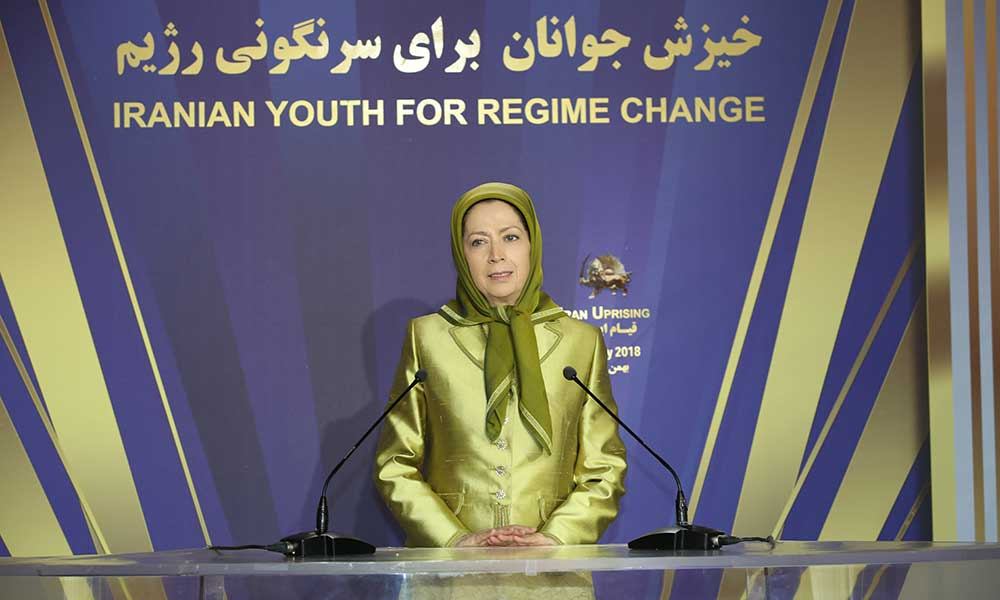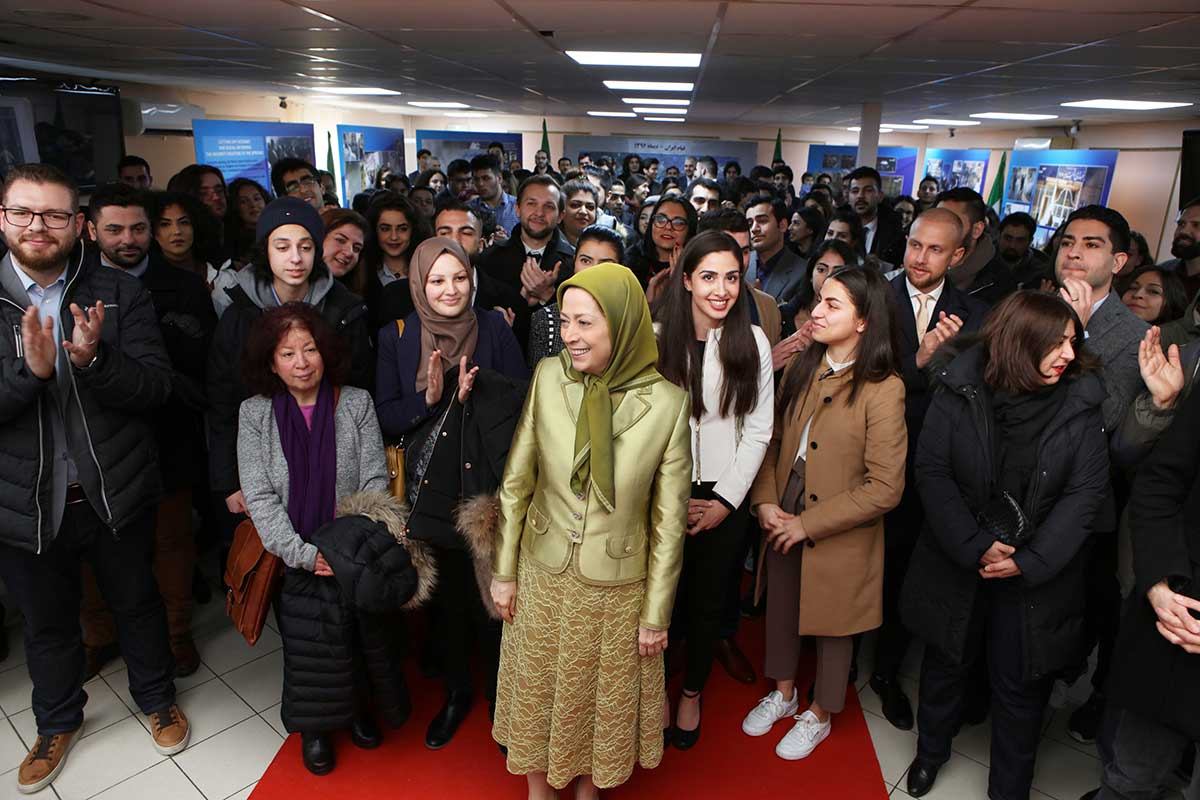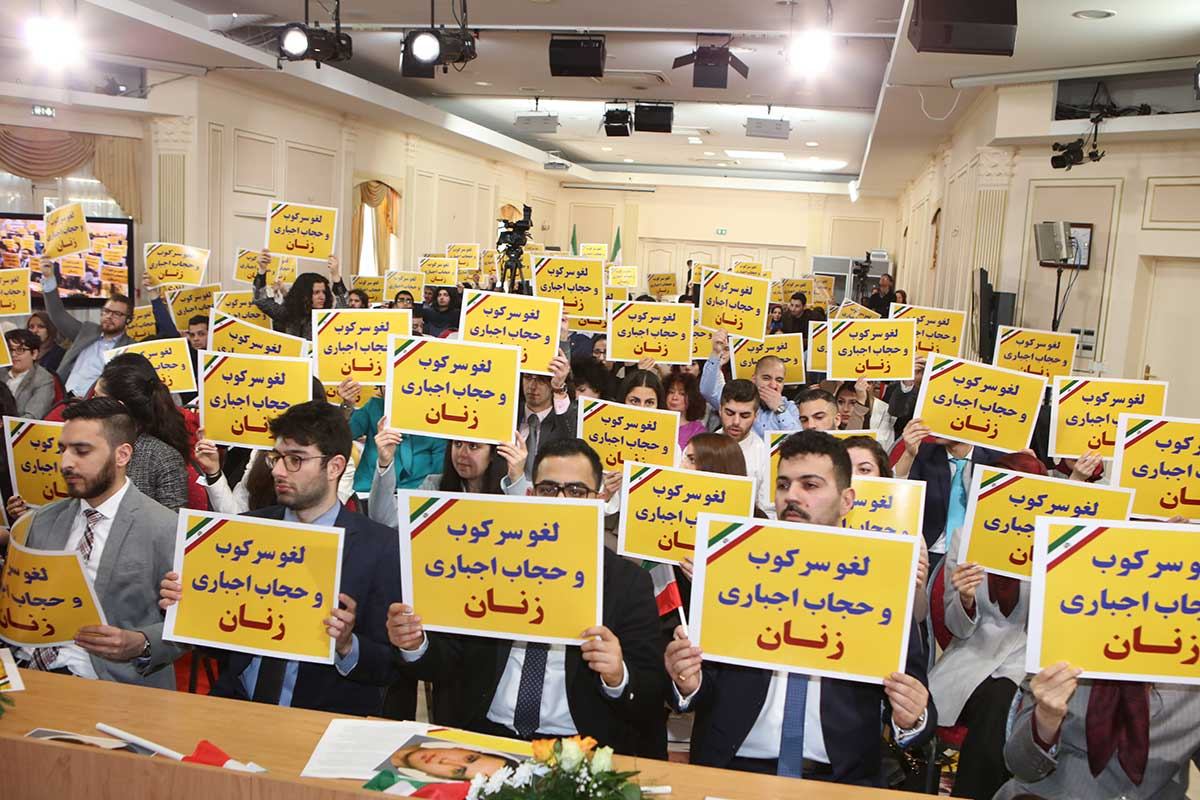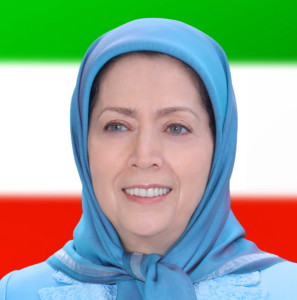Maryam Rajavi: From 1979 Revolution to the Uprising in 2018- For freedom, in the name of freedom, and towards freedom

In remarks marking the anniversary of the anti-monarchic revolution on February 11, 1979, and in the wake of the Iranian people’s uprising December 28, 2017 – mid-January 2018, Maryam Rajavi addressed a meeting on February 10 entitled, “Iran Uprising, Iranian Youths for Regime Change.”
Fellow compatriots, young protesters,
On the anniversary of the 1979 Revolution, I salute the people and youths who overthrew the Shah’s dictatorship and the youths who have risen up today to overthrow the mullahs’ dictatorship. The 1979 Revolution aspired to freedom and democracy in Iran, but Khomeini hijacked its leadership and drenched it in blood. So I salute the brave souls who have arisen today to liberate that revolution from the clutches of the mullahs’ religious dictatorship. They are determined to rescue that hijacked revolution, to wrench it from the wolf’s mouth.
Let us commemorate the visionaries, women and men whose sacrifice created that glorious revolution. I salute a thousand-fold Mohammad Hanifnejad, Saeed Mohsen, Ali-Asghar Badizadegan, Massoud Ahmadzadeh, Amir Parviz Pooyan and Bijan Jazani.
The Shah’s monarchic dictatorship and his colonialist supporters staged a coup d’etat against our historic leader, Dr. Mohammad Mossadeq. The Shah’s dictatorship cracked down on liberation movements and slaughtered them. Group after group of the Mojahedin and Fedayeen were executed or sent to jail.
I remember the 1970s, when the prisons of the Shah’s regime were full of political prisoners. Their families gathered several days a week outside the prisons in various cities to visit their children and relatives. I was among them. I went to visit my brother, Mahmoud. Political prisoners were tortured by the Shah’s secret police, SAVAK. This infuriated the public more and more every day. The society was being repressed and the people yearned for freedom. With the Fedayeen and Mojahedin leading the way, the atmosphere of terror was shattered and the wall of repression collapsed.
In those days, universities were the hub of the anti-shah movement. The protests and strikes increased daily. Ultimately, under the pressure of public protests and demonstrations, the monarchic dictatorship was forced to release the last group of political prisoners January 20, 1979. Massoud Rajavi was accompanied by Moussa Khiabani, Ashraf Rajavi, and a number of other Mojahedin and Fedayeen. Nobody will ever forget that moment when Massoud appeared on the balcony of Qasr Prison and told the people: “It was you and your uprising that set us free.”
And we remember when on January 24, 1979, three days after being freed, Massoud Rajavi went to Tehran University, where he countered Khomeini and instead of defending the so-called Islamic Revolution which bore the aura of a dictatorship under the name of Islam, he clearly defended the Iranian people’s democratic revolution. This was the first time that we and our people heard the term “democratic revolution.” In those days, it took a lot of courage to speak of a “democratic revolution,” because 40 years ago, there were superstitions about seeing Khomeini’s image in the moon.
In that very first speech, Massoud was explicit again, when he said, “The revolution has just begun. I have not come here to admire the spontaneous trend of events. I have not come to admire what already is, to just admire it. Let us take a moment and think about what needs to be done, namely freedom…”
And again, when he said, “Brothers and sisters, the Mojahedin did not sacrifice their lives to gain wealth or high positions.” He emphasized that the sanctity of the word “freedom” ought to be preserved. At the dawn of freedom, Massoud said, “Is it possible to kill the sun? Is it possible to keep the wind from blowing, or the rain from pouring? Is it possible to prevent tulips from growing? And is it possible to keep a nation enchained for good? No. One can never keep a nation forever in chains.”
These were the unforgettable days and moments of that revolution. And of course, they were also a true description of the story of the people of Iran today. By executing the Mojahedin and Fedayeen, the Shah had prepared the best circumstances for Khomeini to hijack the leadership of the revolution. So, he diverted its path towards fundamentalism and tyranny.
The following year, Khomeini had the Velayat-e Faqih Constitution approved. In this way, he established the rule of the mullahs instead of the people. A few years later, he established the absolute rule of the Velayat-e Faqih, meaning the absolute, unconditional authority of the mullahs. When our people rose up, they never asked for such an ominous regime.
Khomeini executed most of the activists of the 1978-1979 uprisings. The youths and teenagers who created the 1979 Revolution were executed in the 1980s and in the 1988 massacre. The young souls massacred in 1988 were mostly those who had led the 1979 Revolution to victory. Khomeini was the enemy of the Iranian people’s aspirations and their revolution. He was the enemy of Mossadeq and the Constitutional Revolution. He was a descendent of Sheikh Fadhlollah and mullah Kashani, and his accomplice in the 1953 coup. Khomeini and Khamenei’s record can be summarized in five phrases: slaughter, plunder, destruction, export of fundamentalism and terrorism under the name of revolution, and misogyny – the most prominent feature of the regime. The entire history of Velayat-e Faqih is summarized in these five phrases.
The people of Iran have never been content with this regime; they have never succumbed to it, and they have never given up their dream of freedom and popular sovereignty. Where can we see this endurance and resistance? In the Iranian people’s historic “NO” to the religious dictatorship. In the Mojahedin (PMOI), the National Liberation Army (NLA), and their perseverance against regional and international conspiracies; in the democratic alternative, the National Council of Resistance of Iran (NCRI); in the countless uprisings throughout Iran, and in the profound awareness of Iranian society.
This awareness is witnessed in particular in the acceptance of equality among Iranian youths. This is Iranian society’s most important achievement in resisting against a misogynous regime. In any scenario, Iran’s future will be founded on the equality of women and men. Iranian society’s awareness can also be seen in its embrace of the principle of separation of religion and state. This principle was adopted along with a specific plan by the National Council of Resistance of Iran in 1985. Iran’s social awareness can also be seen in the failure of fundamentalism, given voice in the slogan chanted in the uprisings – “down with the principle of Velayat-e Faqih.” And finally, the most important symbol of Iranian society’s awareness and maturity is the endurance of a democratic alternative, namely the National Council of Resistance, and more specifically in the element of leadership showing the way, the direction for the uprising.
The uprising which began on December 28, 2017 is a manifestation of all the above values. So the big news is that the religious fundamentalism which was born in Iran in 1979, died in the 2018 uprisings.
Young protesters seeking regime change,
Brave young women and men of Iran,
You set in motion the overthrow of the mullahs in your uprisings in late December and early January. It was an auspicious beginning. Khamenei and his Revolutionary Guard Corps had blocked all ways forward, but your determination was able to break through. Therefore, you should have faith in the continuation of the uprisings. This movement is the product of your suffering and the sacrifices of your comrades. This movement is made from the bleeding hearts of tens of millions of Iranians. This movement is not going to stop, because the circumstances that created it persist. Just as you, the courageous youth of Iran, are going to continue it by being present in every scene.
Dear friends,
Three essential elements were involved in creating the uprising. Those same three elements provide the potential for its persistence: First, accumulated, explosive discontent; second, an overall change in the international atmosphere to the detriment of the regime, and formation of a regional coalition against the regime’s fundamentalist meddling and warmongering; and the third significant factor is the presence of the People’s Mojahedin and the Iranian Resistance and their leading role.
Let me explain the three elements a bit more: First of all, the society is replete with fury and hatred against this regime. The wall of fear has cracked, and the arrests of at least 8,000 people have not undermined the popular resolve to continue the uprising. The Revolutionary Guard Corps (IRGC) and Bassij are demoralized. Everything is prepared to extend and expand the uprisings. Look at the incessant strikes and protests by workers and other blue-collar sectors. Look at the student protests. Indeed, what is the message of these growing protests? Their cries are getting louder every day. They call for freedom, for rising up, and they cry out: I seek the regime’s overthrow.
We hail all those who have arisen, particularly our laboring sisters and brothers. In 1979, the honorable oil workers of Iran brought the Shah’s regime to its knees with their major strike. Today, too, the cries of workers resonate across the country. They are an important part of the uprising and the movement for the overthrow of the regime in Iran. We salute the workers of Iran.
The protests of our compatriots who have been cheated by fraudulent financial firms also continue. They protest against the mullahs’ unbounded corruption and thievery. A couple of days ago, Khamenei said, “Corruption is like the mythical seven-headed dragon.” Yes, the clerical regime’s corruption is a seven-headed dragon, but the head of the dragon head is in the house of Khamenei.
Dear friends,
The second element contributing to the continuation of the uprisings is the change in the international political landscape. Khamenei always, particularly in the past 16 years, benefitted the most from the US policy. If the previous US administrations had not repeatedly opened doors for Khamenei and the clerical regime, if they had not remained silent, the Iranian regime could not have intervened so destructively in Iraq and Syria. It could not have received such concessions as the disarmament, siege and bombardment of the PMOI and NLA.
Today, however, Khamenei’s regime has lost the backing it received through US appeasement. In contrast to the past, the Iranian people’s resolve to rise up and attack the regime will no longer face any foreign barrier.
And the third element is the active role of the PMOI and Iranian Resistance. Fortunately, their leading role provided a new direction for the movement. It is this significant factor that shows the way, directs and protects from diversion. It is this element that leads, guides and ensures that the uprising carries on. This element was embodied in the recent uprisings in the role played by 1,000 bastions of rebellion and 1,000 Ashrafs. The more these bastions of rebellion multiply, the more power your uprising will have.
Indeed, what are the conditions for the formation and expansion of such bastions? One is the popular discontent and potential for rebellion built up in every Iranian city and village; another is the lasting memory of the martyrs and victims of the regime’s massacres. Tuyserkan was the scene of one of the most intense clashes during the uprising. Do you know what is special about this city? It is the place where a number of Mojahedin prisoners were hanged in the streets before the public’s eyes in 1988. Today, that city has turned into a hub of protest.
As the Iranian Resistance’s Leader Massoud Rajavi said in one of his messages to the protesters, “We are stronger than death, executions and massacres. Whenever we are reaped, we grow again, the crop ever greater. We rise up and continue our struggle to uproot the enemy from his foundations, i.e. the principle of Velayat-e Faqih.”
My daughters and sons across Iran,
There is another thing which I would like to remind each and every one of you, and that is your responsibility. You should consider the continuation and expansion of the uprising as your own responsibility. Two years ago, in the annual gathering of the Iranian Resistance, I said, “To achieve a free and just republic, we do not expect any miracles to happen. Nor do we expect any coincidental or chance occurrences in our favor. Our entire asset is the Iranian nation and its vanguard children. And this is indeed the greatest power in the world. So, we must expect everything to be achieved with our own hands and through our own determination. This is why we must establish 1,000 Ashrafs.”
Today, what I want to tell you, courageous youths, is that when you organize, you will have a significant impact. Many of you have played an active role in multiplying one, two, three, 100 and 1,000 Ashrafs. These bastions are capable of creating the uprising and are the best help to the protesters. You can build more bastions and organize the uprising. You can set up these bastions and these councils of resistance in every high school, university, factory, office and neighborhood.
Likewise, you can give assistance to the families of the prisoners and martyrs of the uprising as local groups or individually. You can pass on your experiences in the uprising and guidelines to everyone. The uprising, its continuation and expansion, place numerous duties and responsibilities on the shoulders of every single one of you. Surely, each of you can undertake part of these duties.
Women, youths, workers, laborers and the disenfranchised, you have enormous, explosive potential against the religious dictatorship. Your role at the forefront cannot be replaced by anyone. You should get involved full force, to expand and carry on the uprisings, overthrow this regime and establish freedom.
I would also like to stress that you should not heed talk of the IRGC’s strength. They are powerful only when there are no protests and no uprising. They have power only when everyone surrenders. But when every one of you undertakes a role in the advancement of the uprising, they are paralyzed.
I call on everyone employed by the suppressive forces, and particularly the Revolutionary Guard Corps and Bassij, to defy these criminal forces and reject the shame of serving them. Poverty and destitution are a thousand times better than the wages paid by murderers and torturers. Separate your ranks from those of the executioners who killed the underprivileged youths of Izeh, Doroud and Arak.
I am also addressing the personnel of the Army and the State Security Force. You should refuse every form of cooperation with the criminal IRGC. Do not let the mullahs take advantage of you in spilling the blood of Iran’s children.
And finally, I would like to tell you, the courageous youth of Iran, to remember that in the past several decades, young people your age have repeatedly shaken the rule of dictators. Mehdi Rezaii was only 20 years old when he put the Shah on trial in a military court. Fatemeh Mesbah, Daryoush Salahshour, Massoud Shakiba Nejad and Homeira Eshraq terrified the regime time and again in 1981. And in recent years, Saba Haftbaradarn, Assiyeh Rakhshani, Faezeh Rajabi, Nastaran Azimi, Hanif Imami, Siavosh Nezam, Saeed Akhavan, Rahman Mannani, and other heroes and heroines fueled the flames of perseverance in Ashraf against Khamenei and his mercenaries. Every one of them demonstrated this brilliant message that “you can and must.” With your revolt, your generation has become a de facto symbol of this message. You showed that we can and must rise up under the most repressive conditions. You proved that we can and must set up bastions of rebellion. And surely, you will prove again that we can and must overthrow the clerical regime and establish freedom and popular sovereignty in our homeland.
Now, I would like to have a few words with the youth who are present here. You have important duties with regards to the uprising that erupted in our country. Certainly, if you were in Iran, wherever you lived, you would have been among the protesters. It is key that everyone sees him or herself as responsible, regardless of where he or she is. It is enough to be concerned about the uprising and the protesters. Then you can see that there are so many things you can do. And you can play a serious role in supporting and advancing this uprising. Yes, all of you can and must.
Fellow compatriots,
The recent uprising proved that the Iranian people will not be satisfied by anything less than the overthrow of the clerical regime and establishment of freedom. The participation of women and youths at the forefront of the protests guarantees their continuation. Iranian women have been subjected to systematic suppression and humiliation for 39 years. The compulsory veil and all forms of intolerable oppression and harassment imposed on Iranian women give them the strongest motivation in their struggle to bring down the mullahs’ regime. They have never surrendered to the various forms of repression, the mandatory veil and other forms of coercion. From the onset of Khomeini’s rule, the PMOI women rose up to oppose the compulsory veil and took part in the protest demonstrations of their sisters in Tehran.
I wish to emphasize the demands I mentioned two weeks ago in meetings at the Council of Europe, namely the immediate release of all prisoners of the uprising, freedom of speech and assembly, and the immediate abolition of women’s suppression and the compulsory veil.
We have always and repeatedly said, and I repeat: no to compulsory religion, no to religious compulsion, no to the compulsory veil and no to compulsory government. The time has come to put an end to these coercions.
Iran’s people and protestors are determined to establish a republic based on freedom and democracy. They are determined to overthrow the mullahs’ religious tyranny. They have decided to do away with the Velayat-e Faqih Constitution and replace it with a Constitution based on freedom, equality and democracy. They have decided to topple the Revolutionary Guard Corps and the Bassij. They want to invest in the country’s education, health, sports, social welfare, jobs and economy instead of investing in nuclear programs and other weapons of mass destruction.
This is our road map. The first step in this road is the overthrow of the clerical regime in its entirety. This is our road map in the name of freedom, for freedom and towards freedom.
The dawn of freedom for Iran and all Iranians is imminent.
Hail to the protesters and the protests of the people of Iran
Hail to the martyrs
And God bless you all


- Tags: Iran protests, Mojahedin, NCRI, Uprising

